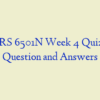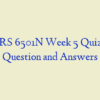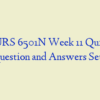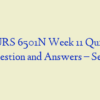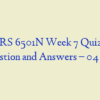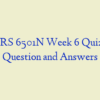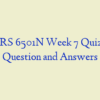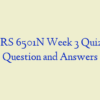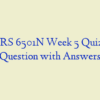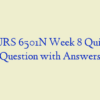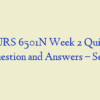Description
NURS 6501N Week 6 Quiz with Answers
- A 6-month-old female presents with rhinorrhea, cough, poor feeding, lethargy, and fever. She is diagnosed with bronchiolitis. Which of the following will the nurse most likely observe on the culture report?
- A nurse is preparing to teach the staff about asthma. Which information should the nurse include? Airway hyper-responsiveness in asthma is related to:
- A 25-year-old male presents with chronic bronchitis of 5 months’ duration. When obtaining the patient’s history, which of the following findings is most likely to cause this condition?
- A 50-year-old male presents with hypotension, hypoxemia, and tracheal deviation to the left. Tests reveal that the air pressure in the pleural cavity exceeds barometric pressure in the atmosphere. Based upon these assessment findings, what does the nurse suspect the patient is experiencing?
- A 60-year-old female with a 25-year history of smoking is diagnosed with emphysema. She has an increased anterior-posterior chest diameter. The nurse attributes this finding to:
- A 20-year-old male is in acute pain. An arterial blood gas reveals decreased carbon dioxide (CO2) levels. Which of the following does the nurse suspect is the most likely cause?
- A 7-month-old male presents with cystic fibrosis (CF) accompanied by failure to thrive and frequent, loose, and oily stools. Sweat testing reveals increased chloride. Which of the following should the nurse observe for that would accompany this disease?
- When the nurse is asked what causes asthma, how should the nurse respond? Asthma is thought to be caused by:
- A 13-year-old female is diagnosed with asthma. Which of the following should the nurse teach the patient to recognize as part of an asthmatic attack?
- An 80-year-old female develops pneumonia in the hospital. She becomes cyanotic, tachycardic, and develops a fever and cough. Chest x-ray reveals pus in the pleural space. Which of the following is the most likely diagnosis documented on the chart?
- A nurse is reviewing the results of an ABG and finds reduced oxygenation of arterial blood. What term should the nurse use to describe this condition?
- Which patient would the nurse assess for paroxysmal nocturnal dyspnea (PND)? A patient with:
- A 65-year-old female with emphysema presents to the ER for difficulty breathing. Physical exam reveals bluish skin and mucous membranes. How should the nurse chart this condition? Patient has:
- A 50-year-old male with a 30-year history of smoking was diagnosed with lung cancer. He was previously exposed to air pollution, asbestos, and radiation at his job. Which of the following should the nurse realize had the greatest impact on the development of his cancer?
- A 57-year-old male presents with cough, sputum production, dyspnea, and decreased lung volume. He is diagnosed with pneumoconiosis. When taking the patient’s history, which finding is the most probable cause of his illness?
- Individuals with a recent diagnosis of emphysema should be assessed for which most common presenting factor?
- A 9-year-old male contracted influenza. Which of the following complications is of greatest concern to the nurse?
- A 50-year-old diabetic male did not take his medication and is now in metabolic acidosis. He is experiencing Kussmaul respirations. What type of breathing will the nurse observe upon assessment?
- If an individual with respiratory difficulty were retaining too much carbon dioxide, which of the following compensatory responses would the nurse expect to be initiated?
- A 28-year-old male reports to his primary care provider that he has had a cold for a week and is coughing up bloody secretions. When giving report, what term should the nurse use to describe this condition?
- A 25-year-old male presents with chronic bronchitis of 5 months’ duration. Which of the following is the most significant concern for the nurse to monitor in this patient?
- A 20-year-old male presents to his primary care provider reporting difficulty breathing when lying down. What term should the nurse use to document this condition?
- A nurse is preparing to teach the staff about asthma. Which information should the nurse include? Airway obstruction contributing to increased airflow resistance and hypoventilation in asthma is caused by:
- A 42-year-old female presents with dyspnea; rapid, shallow breathing; inspiratory crackles; decreased lung compliance; and hypoxemia. Tests reveal a fulminant form of respiratory failure characterized by acute lung inflammation and diffuse alveolocapillary injury. Which of the following is the most likely diagnosis the nurse will observe on the chart?
- A geneticist is discussing cystic fibrosis (CF). Which information should be included? CF is an _____ disease.
- A 10-year-old female develops pneumonia. Physical exam reveals subcostal and intercostal retractions. She reports that breathing is difficult and she feels she cannot get enough air. What term should the nurse use to document this condition?
- A 30-year-old female received a severe head injury in a motor vehicle accident. She is now experiencing respiratory abnormalities characterized by alternating periods of deep and shallow breathing with periods of apnea. What term should the nurse use when charting this condition?
- A 47-year-old male is diagnosed with pulmonary edema. Which assessment findings will the nurse observe?
- A 14-year-old male is experiencing an asthma exacerbation. When reviewing the lab results, which of the following cells in the submucosa promote this inflammatory response and will be elevated?
- A 53-year-old male with a 20-year history of smoking is diagnosed with emphysema. When a staff member asks why the patient’s airways are obstructed, how should the nurse respond? The airways are obstructed because of:


